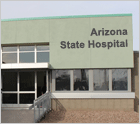 Operating any type of medical or behavioral health facility is a balancing act. It’s especially delicate at the Arizona State Hospital because we deal with patients who suffer from the most severe symptoms of mental illness. Treatment practices at ASH has changed through the years to reflect contemporary approaches. Decades ago, people with mental illness were heavily medicated and expected to stay in an institution for the rest of their lives. Now we know that most mental illnesses are like other chronic diseases… and that with good medication management, therapy, and lifestyle changes, people can live healthy, productive lives.
Operating any type of medical or behavioral health facility is a balancing act. It’s especially delicate at the Arizona State Hospital because we deal with patients who suffer from the most severe symptoms of mental illness. Treatment practices at ASH has changed through the years to reflect contemporary approaches. Decades ago, people with mental illness were heavily medicated and expected to stay in an institution for the rest of their lives. Now we know that most mental illnesses are like other chronic diseases… and that with good medication management, therapy, and lifestyle changes, people can live healthy, productive lives.
Which brings me to the topic of the changes we made in the last couple of years at ASH to improve outcomes. We converted from a 911-style response to an impending or active crisis to a system that uses more direct care staff who are all trained to help de-escalate the situation immediately. It’s called Non-Violent Crisis Intervention. As you might expect, we used evidence to drive our decision-making before we moved to this new model. We researched the system before we changed and are tracking the results – and the results have been very good.
In the first few months, we noticed a difference in patient outcomes – there were fewer times a crisis escalated into a major incident and when they did, fewer patients had to be restrained. That’s another benefit of having more direct patient care staff – teams build rapport with patients which helps prevent situations from escalating in the first place. It also provides teaching moments for patients. Early in a developing situation, teams work with patients to help them understand the consequences before something happens – a principle of Recovery.
We’re now entering the 2nd full year of the Culture of Care and the response from patients and staff is encouraging. Since it started, we’ve trained 748 staff on Non-Violent Crisis Intervention including on-going practice activities. One of the ways that we track the success is the number of injuries to staff and patients. Injuries happen in every business, so we focus on injuries that are tied to interactions with patients – everything from a push, shove or scratch to spitting or more serious injuries is counted.
For example, the number of workers’ compensation claims we have from staff dropped from 311 in 2011 to 101 in the first six months of 2013. That trends out to a one-third drop in claims… something any business would be proud to report. Our increased and more robust effort to capture each incident- no matter how minor- means the raw number of reports are a little higher, but about 90% of the time when an incident report is generated, staff require no medical attention or simple first-aid like a Bandaid. At the end of the day, safety is a priority at the hospital. The Joint Commission considers safety as part of the stringent review it does before accreditating a hospital; The Joint Commission accredited ASH in November of 2011.
As a result of our progress in establishing our Culture of Care, the Arizona State Hospital has been invited by the National Council of Behavioral Health to become a Trauma Informed Care Community. I know that the transition to the evidence-based Non-Violent Crisis Intervention approach hasn’t been easy, and I really appreciate the work our excellent staff at ASH does for our patients and residents in their path to Recovery. Well done.









